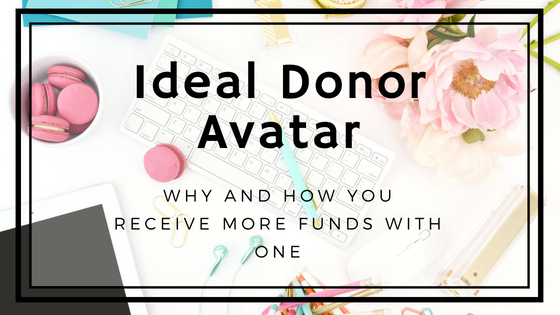Are you wondering where your fundraising dollars will come from? Maybe you don’t know where to start finding those loyal donors. Maybe you’ve figured out that not everyone wants to be part of your organization. You know there are many that will love your cause and be die-hard supporters. But where are they? They are the ones you want in your donor file. In order to find them, you must create your Ideal Donor Avatar, also known as an Ideal Donor Profile.
I admit creating an Ideal Donor Profile is a lot of work. If you are following the 9 Steps Guide, this is Step 6. If you are working on a fundraising plan, this should be done before the Fundraising Plan.
Creating an Ideal Donor Avatar (IDA) will create a profile of a person with general demographics and attitudes that you can speak to in all your messages and communications. It will also attract those like-minded individuals that will become your loyal donors. Ideal Donor Avatars should be created for these four reasons: 1) They help you gain crystal clarity in your nonprofit; 2) They help you narrow your focus for donors; 3) It saves you time and money in the long run because you message and advertising dollars are focused on your small group of mighty supporters; 4) An Ideal Donor Avatar helps answer the questions: Who do we target and where are they?
Now I can already hear you. But Alesha- we are leaving people out! We are leaving money on the table! It certainly seems that way. The reality is that the majority of those people will never give or give consistently. And we are not leaving people out. You will still have people donate outside of your Ideal Donor Avatar. But why not focus on those people who have a deep passion for what you do, give more money, and give consistently? Those are the people who make up the Ideal Donor Avatar.
How Do You Create an Ideal Donor Avatar?
First, let’s define a few terms.
Psychographics- things that describe a person like their values, attitudes, lifestyle, and interests. Psychographics help you answer the questions why they behave as they do and where they can be found.
Demographics
Now, think about the ideal donor for your organization. (Let’s focus on one for now. You may find out you have more than one, though). What is the basic information of someone who donates to your organization? Are they predominantly male or female? How old are they? What occupation do they have? Where do they live- a home, an apartment, a camper?
Psychographics
Dig deeper now.
- What are their attitudes toward your cause and giving in general?
- What words or phrases would they use to describe your organization or cause?
- What values do they have? What are their pain points- things that keep them up at night?
- What is their vision of the future world they live in?
- What are things outside your cause they interested in?
- How many organizations do they give to?
- What TV stations, radio stations, and media do they consume?
You may find that you had a Board member or donor in mind when you went through the exercise. They may be your ideal donor. If you need to, survey your Board members or current donors who fit your Ideal Donor Avatar.
Tell Their Story
Here is the fun part! Give this person a name. Draw a picture or google pictures. Put a face with the name. You can also use websites like uifaces.com or FaceYourManga to help you. Tell their story to help you remember who they are. Write their story down and share with your Board.
How to Use Your Ideal Donor Avatar
Once your IDA is written, use this ideal donor to attract others of like age, income, and interests (among other things you learned).
Your research should have brought up where they are online and in real life. You should have enough information for Facebook ads or any other ads you want to place for events. Your IDA should guide you to plan all of your fundraising activities.


 Most nonprofit leaders lay awake at night trying to figure out how to fund their mission.
Hi! I'm Alesha.
I teach sustainable fundraising in a way that they can take action today so they can serve their clients.
I can help you move from just getting started funding your new nonprofit to gaining confidence in your fundraising and building relationships to knowing what works for your organization and looking at the infinite game when it comes to funding. I’ve worked with nonprofit Founders and written the book I HAVE MY 501(C)3! NOW WHAT?!? Your Blueprint to Starting Your Nonprofit Without Being the Sole Funder that lays the foundations for funding in a new nonprofit.
I’ve worked in Development (Fundraising) Departments in large organizations and I know the no cost, low-cost methods they use to bring in funding. I bring those sound strategies to the nonprofits I serve.
Most nonprofit leaders lay awake at night trying to figure out how to fund their mission.
Hi! I'm Alesha.
I teach sustainable fundraising in a way that they can take action today so they can serve their clients.
I can help you move from just getting started funding your new nonprofit to gaining confidence in your fundraising and building relationships to knowing what works for your organization and looking at the infinite game when it comes to funding. I’ve worked with nonprofit Founders and written the book I HAVE MY 501(C)3! NOW WHAT?!? Your Blueprint to Starting Your Nonprofit Without Being the Sole Funder that lays the foundations for funding in a new nonprofit.
I’ve worked in Development (Fundraising) Departments in large organizations and I know the no cost, low-cost methods they use to bring in funding. I bring those sound strategies to the nonprofits I serve.